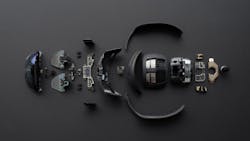Qualcomm to Work With Microsoft on Custom Chips for AR Glasses
Check out our CES 2022 coverage.
Qualcomm is partnering with Microsoft to support the growing number of companies developing apps and other software for the metaverse and help users interact with each other once inside virtual worlds.
At the 2022 Consumer Electronics Show (CES), Qualcomm CEO Cristiano Amon said it is working with Microsoft to design custom chips that will power ultra-light augmented reality (AR) glasses for use by both consumers and businesses. Through the pact, the companies are also working to integrate a set of software tools for augmented reality: Microsoft Mesh and Qualcomm's Snapdragon Spaces.
Metaverse is a relatively new term that refers to the concept of virtual worlds that blur the line between physical and digital realities, in some cases using virtual reality headsets to access imaginary worlds or AR glasses to overlay digital objects on physical scenes. For instance, while wearing a headset, users can meet with each other or even collaborate on projects such as building a bridge or designing a car.
Qualcomm said the new chip would include software called Snapdragon Spaces, a suite of software tools that help perform many of the computing tasks that AR glasses need to sense and adapt to the physical world. This includes mapping a person's surroundings to project objects on top of the scene, and tracking the person's hands so they can manipulate objects using their hands or other gestures.
Qualcomm said the new chip will also be designed to work with software from Microsoft called Mesh that allows a person to share a hologram—or animated “avatar”—of themselves with another person's augmented reality glasses or mixed reality headset so it feels as if they are meeting in the same room.
“We have been talking for years about the possibility of having wearable augmented reality devices that will gain scale,” Amon said, adding the Microsoft partnership “is a step in making that a reality."
Qualcomm is currently the world's largest vendor of baseband modems and other smartphone chips. But it is also investing aggressively in chips at the heart of Internet of Things devices such as smart watches and high-end wireless headphones.
Qualcomm has also specifically designed chips for augmented reality gear, including the Snapdragon XR2 at the heart of Meta’s Oculus Quest 2 headset, which executives estimate has sold 10 million units.
The semiconductor giant sells the Snapdragon chips at the heart of Microsoft’s HoloLens 2 mixed reality headset, released in 2019. While wearing the headset, users can see instructions and other data projected on the physical world. They can also interact with digital objects by using their fingers to grab the corners of the object and drag and drop it in the environment by using their voice or other gestures.
While consumers could use the glasses to meet in a physically accurate 3D space, engineers could use them to design a digital twin of a car before building on it. Workers can use them for training purposes.
Said Rubén Caballero, corporate vice president of mixed reality at Microsoft: “Our goal is to inspire and empower others to collectively work to develop the metaverse future–a future that is grounded in trust and innovation.”
Qualcomm declined to reveal when it plans to roll out the chips or when Microsoft plans to release headsets equipped with them.
About the Author
James Morra
Senior Editor
James Morra is the senior editor for Electronic Design, covering the semiconductor industry and new technology trends, with a focus on power electronics and power management. He also reports on the business behind electrical engineering, including the electronics supply chain. He joined Electronic Design in 2015 and is based in Chicago, Illinois.

